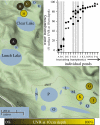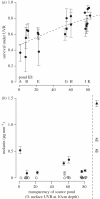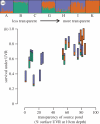Adaptation to local ultraviolet radiation conditions among neighbouring Daphnia populations
- PMID: 20943691
- PMCID: PMC3061130
- DOI: 10.1098/rspb.2010.1663
Adaptation to local ultraviolet radiation conditions among neighbouring Daphnia populations
Abstract
Understanding the historical processes that generated current patterns of phenotypic diversity in nature is particularly challenging in subdivided populations. Populations often exhibit heritable genetic differences that correlate with environmental variables, but the non-independence among neighbouring populations complicates statistical inference of adaptation. To understand the relative influence of adaptive and non-adaptive processes in generating phenotypes requires joint evaluation of genetic and phenotypic divergence in an integrated and statistically appropriate analysis. We investigated phenotypic divergence, population-genetic structure and potential fitness trade-offs in populations of Daphnia melanica inhabiting neighbouring subalpine ponds of widely differing transparency to ultraviolet radiation (UVR). Using a combination of experimental, population-genetic and statistical techniques, we separated the effects of shared population ancestry and environmental variables in predicting phenotypic divergence among populations. We found that native water transparency significantly predicted divergence in phenotypes among populations even after accounting for significant population structure. This result demonstrates that environmental factors such as UVR can at least partially account for phenotypic divergence. However, a lack of evidence for a hypothesized trade-off between UVR tolerance and growth rates in the absence of UVR prevents us from ruling out the possibility that non-adaptive processes are partially responsible for phenotypic differentiation in this system.
Figures




References
-
- Lynch M., et al. 1999. The quantitative and molecular genetic architecture of a subdivided species. Evolution 53, 100–11010.2307/2640923 (doi:10.2307/2640923) - DOI - DOI - PubMed
-
- Lande R. 1992. Neutral theory of quantitative genetic variance in an island model with local extinction and colonization. Evolution 46, 381–38910.2307/2409859 (doi:10.2307/2409859) - DOI - DOI - PubMed
-
- Scheiner S. 1998. The genetics of phenotypic plasticity. VII. Evolution in a spatially-structured environment. J. Evol. Biol. 11, 303–320
-
- Scheiner S. 1993. Genetics and evolution of phenotypic plasticity. Ann. Rev. Ecol. Syst. 24, 35–6810.1146/annurev.es.24.110193.000343 (doi:10.1146/annurev.es.24.110193.000343) - DOI - DOI
-
- Kinnison M. T., Hendry A. P. 2001. The pace of modern life II: from rates of contemporary microevolution to pattern and process. Genetica 112, 145–16410.1023/A:1013375419520 (doi:10.1023/A:1013375419520) - DOI - DOI - PubMed
Publication types
MeSH terms
LinkOut - more resources
Full Text Sources

